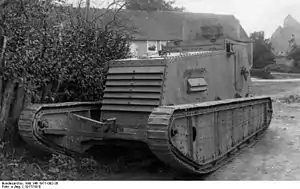LK I
The Leichter Kampfwagen (English: light combat car) or "LK I" was a German light tank prototype of the First World War. Designed to be a cheap light tank as opposed to the expensive heavies coming into service at the time, the tank only reached the prototype stage before the end of the war.
| Leichter Kampfwagen LKI | |
|---|---|
 | |
| Type | Light tank |
| Place of origin | German Empire |
| Service history | |
| Used by | German Empire |
| Specifications | |
| Mass | 6.9 t |
| Length | 5.1 m |
| Width | 1.9 m |
| Height | 2.5 m |
| Crew | 3 |
| Armor | 8–14 mm |
Main armament | 1 × 7.92 mm MG 08 machine gun |
| Engine | Daimler-Benz 4-cylinder 60 hp (44.7 kW) |
| Suspension | unsprung |
Operational range | 70 km |
| Maximum speed | 14–18 km/h |
History
The LK I was designed by Joseph Vollmer. It was based on a Daimler car chassis, using the existing axles to mount sprocket and idler wheels. Its design followed automobile practice, with a front-mounted engine and a driving compartment behind it. It was the first German armored fighting vehicle to be equipped with a turret, armed with a 7.92 mm MG08 machine gun.
Only two prototypes were produced in mid 1918, but no vehicles were ordered.[1] It was designed as an experimental cavalry tank to pave the way to LK II.[2]
Notes
- Õun, Mati (1998). Wermachti tankid. Väike tankiõpik vana sõjatehnika huvilisele. Tallinn: Tammiskilp. p. 5.
- Chant, Christopher (2002). World Encyclopedia of the Tank. Second edition. England: Sutton Publishing. p. 46. ISBN 0-7509-3147-7.